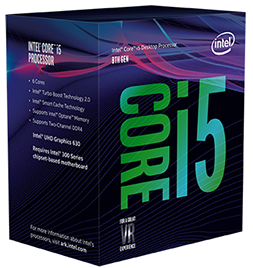Intel Core i5-8600K Review: Coffee Lake’s Jolting Value

Meet Intel’s First Six-Core Core iMeet Intel’s First Six-Core Core i5
For years, Intel dominated the high-end CPU market. As a result, enthusiasts had to pay a premium for its best processors. But AMD’s four-, six-, and eight-core Ryzen models forced Intel to reconsider its value story. Our recent Core i7-8700K review showed that the company is serious about defending its turf. The six-core Coffee Lake-based flagship maintained the architecture’s strength in lightly-threaded tasks, while extra Hyper-Threaded cores improved its performance in the heavy workloads AMD is doing so well in.
A $390 price tag is painfully expensive for most power users, though. That’s why Tom’s Hardware historically recommended Intel’s unlocked Core i5 models to gamers. So how does the new Core i5-8600K fare against Core i7-8700K and, perhaps more important, AMD’s Ryzen 7 and 5 CPUs?
Intel Core i5-8600K
Like the Core i7-8700K, Core i5-8600K sports six physical cores based on Intel’s Skylake architecture. Hyper-Threading is disabled, similar to previous-generation Core i5 models. However, we still expect significant speed-ups across our benchmark suite thanks to higher clock rates and core count. Core i5-8600K features a similar graphics engine as its predecessor (never mind the UHD Graphics 630 branding), though it does benefit from a 50 MHz boost to 1150 MHz.
At the heart of Coffee Lake is Intel’s 14nm++ manufacturing process. Delaying 10nm transistors forced the company to further refine its 14nm node. Attractive power optimizations, such as 52%-lower leakage than the original 14nm process, play a key role in enabling higher core counts within the same TDP envelope. Improved manufacturing yields higher performance as well; despite Core i5-8600K’s more complex die, its 4.3 GHz peak Turbo Boost frequency is still higher than Core i5-7600K’s 4.2 GHz ceiling.
| 14nm Broadwell (2014) |
14nm Skylake (2015) |
14nm+ Kaby Lake (2017) |
14nm++ Coffee Lake (2017) |
|
| Maximum Turbo Frequency (GHz – Core i7 family) |
3.8 | 4.3 | 4.5 | 4.7 |
| Estimated Maximum Overclock Frequency (GHz – Conventional Cooling) |
4.1 | 4.6 | 5.0 | 5.2 |
Of course, incrementally-higher peak clock rates are great. But adding 50% more cores promises to have a much more significant impact on the threaded benchmarks in our suite. Those workloads are the ones that AMD currently dominates. Intel did have to sacrifice base frequency in order to wedge six cores into a 95W TDP, though. Whereas the -7600K guaranteed 3.8 GHz across four cores, Core i5-8600K’s base rate is 3.6 GHz. Consider this, though. With Turbo Boost enabled and four cores active, the -7600K hits 4 GHz. Core i5-8600K can take four cores up to 4.2 GHz, while its six-core bin maxes out at 4.1 GHz.
| Active Cores |
1 |
2 |
4 |
6 |
| Intel Core i5-8600K |
4.3 GHz | 4.2 GHz | 4.2 GHz | 4.1 GHz |
| Intel Core i5-7600K |
4.2 GHz | 4.1 GHz | 4.0 GHz | – |
We also get a few extra cache slices as a byproduct of the additional cores, so the -8600K features 9MB of L3, compared to -7600K’s 6MB. Memory improvements play a role in Coffee Lake’s higher performance, too. The -8600K supports up to DDR4-2666, moving up to 42.7 GB/s across two 64-bit channels, versus DDR4-2400’s 38.4 GB/s.
As we discussed in Core i7-8700K Review: Coffee Lake Brews A Great Gaming CPU, Intel improved the trace layout on Z370 motherboards to support the increased memory transfer rate. It also revised the power alignment inside the LGA 1151 interface to better accommodate the new six-core CPUs. This means you can’t drop Coffee Lake-based processors into Z270 or Z170 motherboards. The requirement is a technical one, though that obviously doesn’t make enthusiasts who recently purchased Z270 platforms feel any better.
Specifications
- Socket
LGA 1151 - Cores / Threads
6 / 6 - Base Frequency
3.6 GHz - Boost Frequency
1 core: 4.3 GHz, 2 cores: 4.2 GHz, four cores: 4.2 GHz, 6 cores: 4.1 GHz - Memory Speed
DDR4-2666 - Memory Controller
Dual-Channel - Unlocked Multiplier
Yes - PCIe Lanes
x16 Gen3 - Integrated Graphics
Intel UHD Graphics (up to 1150 MHz) - Cache
10.5 MB - Architecture
Coffee Lake - Process
14nm++ - TDP
95W
Core i5-8600K’s unlocked multiplier fits well with the Z-series boards, which are needed in order to manipulate its ratio. Intel also added a few new overclocking knobs and dials, such as per-core overclocking support, live memory timing adjustments, and memory multipliers up to 8400 MT/s. Like all of Intel’s K-series processors, you’re on the hook for a thermal solution; Core i5-8600K doesn’t come with an air- or closed-loop liquid cooler.
Beyond the price of a heat sink or all-in-one, you’re also looking at a steep premium over Core i5-7600K. Street pricing on the -8600K is currently $280, while the -7600K sells for $240. AMD’s Ryzen 5 1600X is also available at $240, and the recently price-reduced Ryzen 7 1700 sits right around $300. Going the Ryzen route gives you the option of a lower-cost B350-based motherboard. And as if AMD’s story needed strengthening, a bundled Wraith Spire cooler all but guarantees you could have an 8C/16T platform for less money than Intel’s 6C/6T alternative. As always, we’ll have to rely on the benchmarks to guide our recommendations.